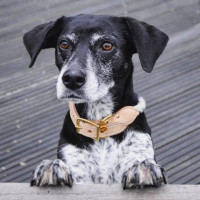 |
Rottmatian |
|
He is not recognized by the F.C.I. |
Origin |
Germany <> Croatia -> U.S.A. | |
Translation |
Francis Vandersteen |
A brief presentation of the Rottmatian |
| This wonderful mix of Dalmatian and Rottweiler is called the Rottmatian and is a wonderful watchdog and family pet. The Dalmatian is a medium to large breed and the Rottweiler is a large breed, so the Rottmatian is generally a medium to large dog weighing around 36 kilos and measuring around 58.5 centimeters. The Rottmatian is a loyal and courageous dog who is a born protector but is also friendly enough to be your children's best friend. They don't need much maintenance as they have a short, flat coat and are very easy to train due to their intelligence and obedience. |
History of the Rottmatian |
| The Rottmatian has only been around for about 20 years, so to get to know your dog better, you need to look at the histories of the Dalmatian and the Rottweiler. |
A little of the Rottweiler |
||
| The Rottweiler comes from a mix of German Shepherds, Mastiffs and Roman dogs for use as cattle drovers and guards. They have been around since the first century and were extremely handy on the farm for pulling wagons and carts as well as herding and guarding livestock. They were also used as guard dogs for the home and were eventually discovered as excellent family pets, due to their adorable nature. The breed was named after the town in which it was discovered, Rottweil, after the community's red-tiled houses and cottages. The breed standard was set in 1901 and the American Kennel Club recognized them 30 years later. | ||
 |
||
| Standard of the Rottweiler |
A little of the Dalmatian |
| The Dalmatian originated in the Mediterranean country of Dalmatia, which is how it got its name. In 1771, a man named Thomas Pennant gave the breed its name after discovering the Dalmatian. There were works of art found depicting the spotted dog in a church in Croatia in the 16th century, but they are considered older than that. Although their history is not well known, the breed is thought to have existed much longer because of illustrations found in Egyptian tombs. Because of their intelligence, friendliness and affinity for horses, Dalmatians were used to run alongside fire carriages to guide horses to the fire. These intelligent, loyal dogs have also been well known for their ability to hunt, drive, herd and play. In fact, they became extremely popular after the children's film 101 Dalmatians became a hit in 1961. However, they had already been recognized by the American Kennel Club since 1888 and are still the 62nd most popular dog breed in the USA. |
 |
| Standard of the Dalmatian |
Appearance of the Rottmatian |
| Rottmatians are medium to large dogs, generally weighing around 36 kilos and measuring around 58.5 centimeters when fully grown. They have a rectangular-shaped head with almond-shaped brown eyes and a large black nose on a long muzzle with strong jaws. Their color is usually black and white like the Dalmatian, but can also be brown and black like the Rottweiler. They can also be a mixture of other colors such as merle, pinto, sable or brindle. The Rottmatian has soft, triangular ears and a short, strong neck on a stocky body with long legs and a long tail. |
Temperament of the Rottmatian |
| The Rottmatian is an extremely friendly, fun-loving dog that is not only people-oriented but also happy to play with other pets, even cats. They're good with children, although they can be a little too bulky for preschoolers to play with. Always make sure you supervise your dog with any small children just to be on the safe side. Their intelligence makes them easy to train, and they're obedient enough to follow commands quickly and consistently. They're quick to learn new tricks and learn too. Although they love being with their human family, they are independent and don't mind being left alone for a while. |
Needs and activities of the Rottmatian |
| The Rottmatian needs at least an hour to 90 minutes of brisk exercise every day to keep them from getting bored or restless. Taking one or two walks every day and letting them play in the yard for an hour or so is enough, but don't forget that they also need mental stimulation and time with their human family. These dogs love to run and play ball, so they'll enjoy a game of fetch or flyball with you. They're also good at agility and obedience competitions, so you might want to try that. Hunting and swimming are also on their list of fun activities. |
Maintenance of the Rottmatian |
| Brushing your Rottmatian once a week with a bristle brush or rubber curry glove should be enough to keep their coat short and smooth and feeling healthy. They don't shed most of the time, but during autumn and spring, you may need to brush your dog more often to avoid excessive shedding. A brush or detangler can be a good tool for the job. Because of their fast-growing nails, you should trim them with nail clippers once a month to prevent cracking or breaking. It's also important to keep your dog's ears clean, as they are susceptible to ear infections. Teeth shouldn't be neglected either: brush them two or three times a week. |







 English (United Kingdom)
English (United Kingdom)